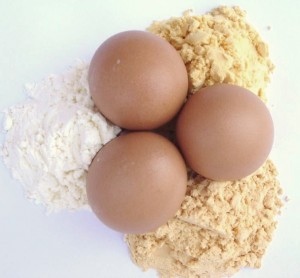
The incredible edible powdered egg.
Despite the at-times negative media attention (we all know how reliable the main-stream media is nowadays) eggs are a very nutritious source of food that is one of the cornerstones in baking. With it’s low-cost but high-quality source of protein, if it weren’t for its short shelf life and fragility, it would be a great addition to your survival store if only you could store it.
Well, unbeknownst to many people, eggs can in fact be stored (up to 10 years if stored correctly) in the form of dehydrated egg powder — perfect for bug-out bags, camping trips and long-term food storage.
They can be used in baked goods just like normal eggs or reconstituted and made into fluffy scrambled eggs.
Here’s how you can do it at home:
What You’ll Need
- A food dehydrator (I use a cheap Walmart version)
- Eggs
- Something to store the powder in when complete
How to Make Powdered Eggs
The process for making powdered eggs is fairly simple. However there are two ways (one which creates a far superior product but more on that later), let me explain the process for both:(In these examples, I used a half-dozen eggs for the cook-dry method and another half-dozen eggs for the wet-dry method)
The Cook-Dry Method
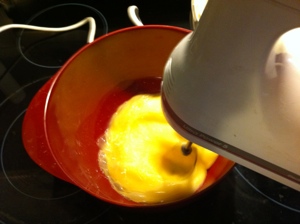 | Step 1: Whip up a half-dozen eggs using a blender (for a more complete mixture). And then then in a non-stick frying pan, cook the egg solution like you would when making scrambled eggs. |
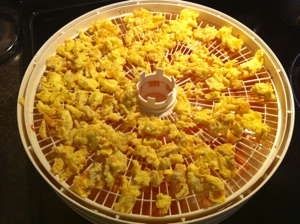 | Step 2: Place cooked eggs onto a drying rack in your dehydrator and set the temperature to about 145 degrees Fahrenheit. |
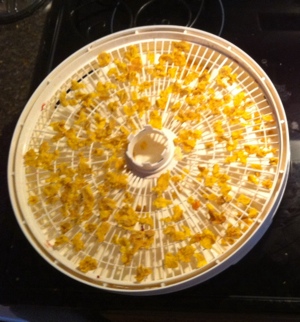 | Step 3: Let dry for around 4 hours until completely brittle throughout. |
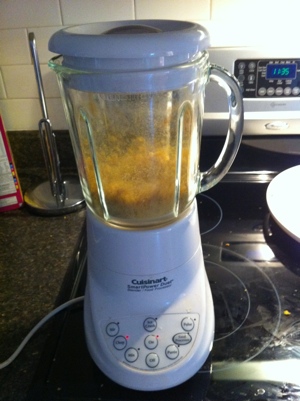 | Step 4: Chop dried chunks in a blender or food processor (or coffee grinder) until it has a fine powdery constancy. Bag it and store it away. |
The Wet-Dry Method
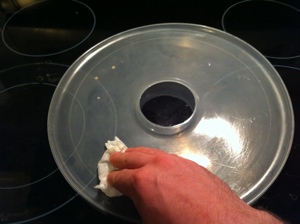 | Step 1: Lightly grease a fruit roll sheet (it comes with the dehydrator) with a paper towel. |
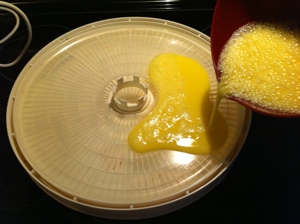 | Step 2: Whip up a half-dozen eggs using a blender (not necessary but it does make for a a more uniform mixture). Pour the egg slurry into the fruit-roll sheet and set the temperature to about 145 degrees Fahrenheit. |
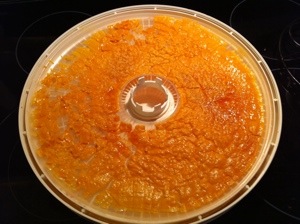 | Step 3: Let dry for around 16 hours until completely brittle throughout. |
 | Step 4: Place dried chunks in a blender or food processor (or coffee grinder) until it has a fine powdery constancy. Bag it and store it away. |
Here’s a picture showing the final result of both the wet-dry and cooked-dry method of dehydrating. Each half-dozen eggs dehydrated produced almost exactly a half a cup of powder. You can also see how the wet dry method produces an orange powder (this color turns back to yellow when reconstituted and cooked).:
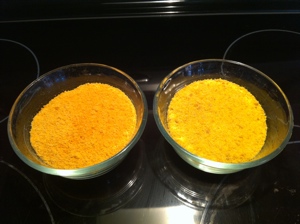
My Results
When comparing the two methods there is most definitely a clear winner — the wet dry method.This is surprising since most of the information found online and in books explains that you should use the cook-dry method. Their main reasoning is that by cooking them it will kill any potential salmonella bacteria. I find this point irrelevant since after reconstituting them you will be cooking with them anyways (as you would with the original eggs) which will kill the salmonella.
The only advantage I found with the cook-dry method is the quickness of the drying time (four hours compared to 16 with the wet-dry method). Beyond that, when reconstituting the cook-dried eggs and cooking them like scrambled eggs, they have a grainy texture, and they taste dry and stale. They also do not fluff up like normal eggs when cooked in a pan. I assume this lack of “rising” would not work to well in baked goods that require this “leavening” property.
The wet-dry method produces a much better product. Although the powder turns initially orange, when reconstituted and cooked like scrambled eggs, the orange turns to yellow and they taste, look, and feel just like non-dehydrated egss. They also maintain the “leavening” property and fluff up which is important for baking.
Here’s a picture of the two in powder form with their resultant reconstituted and cooked product:
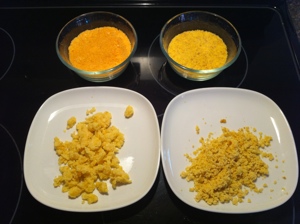
How to Use Powdered Eggs
Uses of Powdered Eggs
Powdered eggs can be used in the same exact manner as regular eggs. The only thing you’ll not be able to do is create things like poached eggs, or sunny-side-up eggs etc. But for all other needs like baking, french toast, scrambled eggs and so on, you’ll have the same results — but in a much more compact and storage-friendly form.How to Reconstitute Powdered Eggs
Reconstituting powdered eggs is a simple process. To make the equivalent of one average sized egg mix 1 heaping tablespoon of egg powder together with 2 tablespoons of water. Stir it up, let it sit for 5 min and use as you would normal eggs.http://tacticalintelligence.net/blog/how-to-make-powdered-eggs.htm
No comments:
Post a Comment
Note: Only a member of this blog may post a comment.